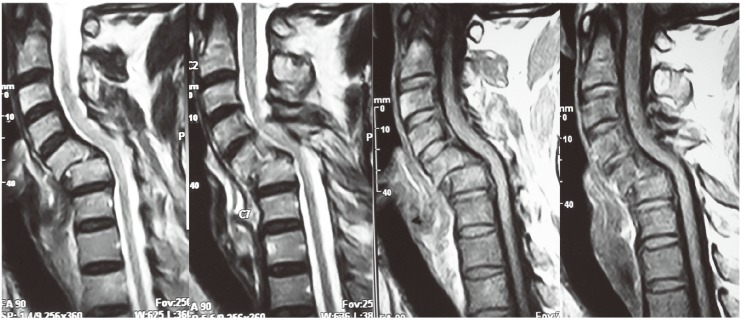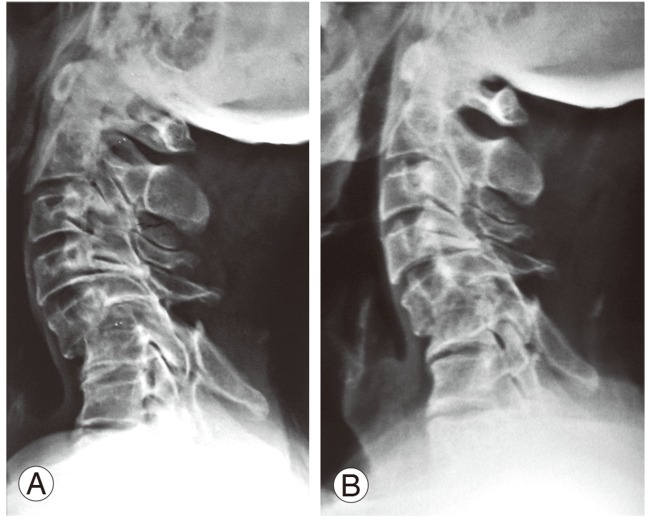Neglected Fracture-Dislocation of the Cervical Spine without Neurological Deficits
Article information
Dear Sir,
Neglected spinal injuries, either secondary to overlooked diagnosis [1] or due to circumstantial and socio-economic factors [2], are not uncommon but discussed infrequently in the literature [1,2]. A 72-year-old male had history of a slip and fall episode three years ago in a construction field. At that time, he had weakness of all four limbs with bowel and bladder involvement. He was managed conservatively because of financial instruments. He recovered completely over a period of six months. Now, he presented with mild persistent neck pain. On examination, except mild spasticity, there were no motor or sensory deficits. Initial magnetic resonance imaging of the cervical spine showed dislocation of C5 over C6, and the spinal cord was stretched over the dislocated vertebral bodies (Fig. 1). There was no evidence of cord edema or cord contusions. He had one follow up X-ray of the cervical spine at one year after the injury, and it showed a fusion of the C5 and C6 vertebral bodies (Fig. 2A). Recent X-ray of the cervical spine showed increased and complete ossification of the C5 and C6 vertebral bodies (Fig. 2B). In view of the solid fusion and no neurological deficits, the patient continued with conservative management with analgesics.

Initial magnetic resonance imaging of cervical spine showing dislocation of C5 over C6 and the spinal cord was stretched over the dislocated vertebral bodies.

(A) One follow-up X-ray of the cervical spine at one year after the injury showed fusion of C5 and C6 vertebral bodies, and (B) Recent X-ray of the cervical spine showed increased and complete ossification of the C5 and C6 vertebral bodies.
Patients with neglected spinal injuries can present with neck pain, restricted neck movements, or clinical features of progressive myelopathy [2-4]. Treatment of neglected spinal injuries needs to be individualized, depending on patient's age, medical condition, severity of myelopathy, and stability spine [5-8]. Aggressive surgical treatment is reserved for younger patients with progressive myelopathy, secondary to dynamic instability [9]. Conservative approach has been suggested for elderly patients with stable, non-progressive deformity [5-8]. In the present case, the reactive new bone formation around the fractured segments might have helped in preventing abnormal movements and development of myelopathy.
Neglected spinal injuries are defined as injuries not treated in a timely fashion and found late when options for care are limited [1]. Also, neglected spinal injuries may result when the comprehensive management is not initiated in a timely fashion [2]. These lesions have a much higher incidence of complications, which are more severe and difficult to manage, requiring longer hospitalization, adding to the costs and adversely affecting the functional outcomes [1,2].
In summary, for neglected spinal injuries, either untreated or inadequately treated with progressive deformity, persistent pain and late presentation are more often seen in the developing countries [1]. In rare circumstances (as in present case), neglected complete fracture-dislocations patients can make excellent recovery without neurological deficits [10].
Notes
No potential conflict of interest relevant to this article was reported.